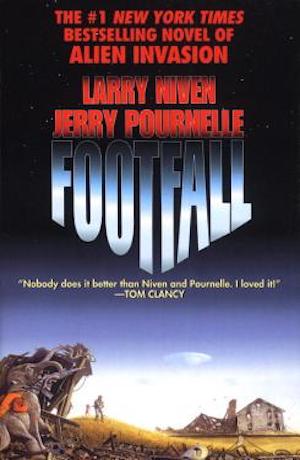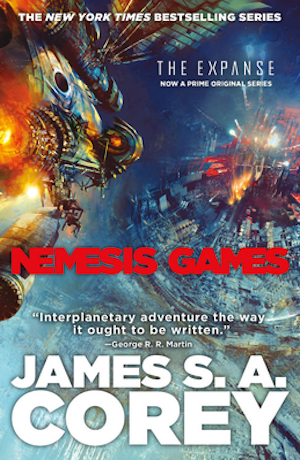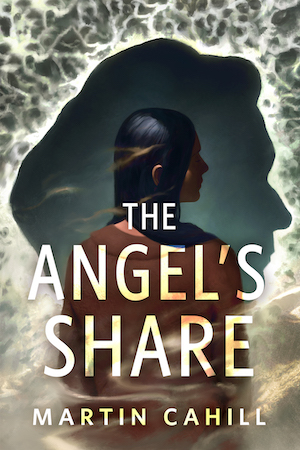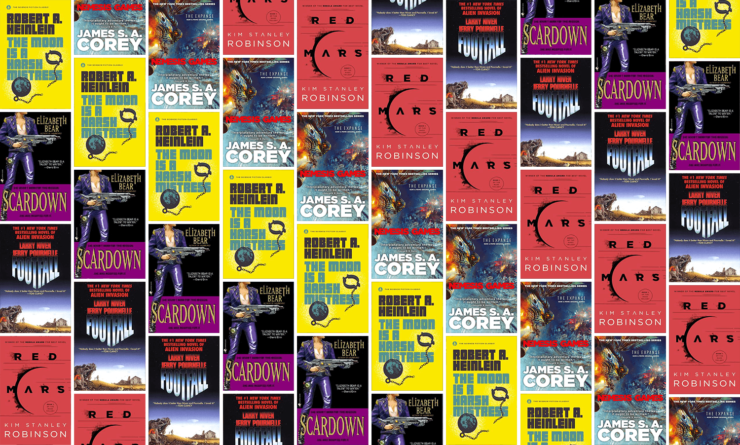There are many reasons one might have reservations about Robert Heinlein’s 1966 The Moon Is a Harsh Mistress—the peculiar stats, the reliance on a nigh-all powerful AI on the rebels’ side, the inexplicable moment where the narrator creepily objectifies a dead tween as she is violently killed—but for me, Heinlein’s use of kinetic weapons ranks especially high on my list.
I know a lot of you are too young to know what I am talking about—the book is, after all, ancient beyond measure—so a quick explanation: in the novel, the rebels commandeer a linear accelerator to lob cargo pods full of rocks to the Earth. The shock and awe inspired by the orbital bombardment helps to sway the Earth into granting the Moon its independence.
On the surface, this seems plausible. A quick back-of-the-envelope calculation assures one that this would be quite vexing to anyone standing where the rock happens to land: at 11 kilometres per second, each kilogram of rock would have about 60 megajoules of kinetic energy, more than ten times the energy of a kilogram of TNT. Nobody wants more than ten kilograms of TNT exploding on their lap.
But…a moment’s consideration should raise concerns. For example, the rebels are using repurposed cargo vessels. How is it they are able to reach the surface at near-escape velocities without fragmenting on the way down? How did the rebels manage to erase Cheyenne Mountain from existence when (given the numbers in the book) it would take about two hundred thousand impacts to do so? How did the rebels cause a tidal wave in the UK when simple math says the wave would only have been a few centimetres high at Margate?
Heinlein probably relied on a simple but useful technique: he didn’t do the math. Perhaps he didn’t have access to the proper equations (although one can make do with Glasstone’s The Effects of Nuclear Weapons, and who doesn’t have a copy of Glasstone within reach?). Perhaps it was just too fun an idea to ruin it with mere facts. He did succeed in convincing a lot of SF authors that kinetic weapons moving at mere kilometres per second could have nigh-nuclear impact, when in fact they are only about an order of magnitude more energetic than chemical explosives. To get nuclear-weapon-level damage from impactors, either the impactor has to be moving a lot faster than interplanetary velocities or it has to be massive.
Nevertheless, Heinlein’s dramatic licence in The Moon is a Harsh Mistress has inspired a number of authors. Take these four other books, for instance:
Footfall by Larry Niven and Jerry Pournelle (1985)

The dismal prospect of a progressive (and thus feeble) America supine under the Soviet Union’s inevitable and unstoppable superiority becomes a side issue when aliens attack! They use the kinetic gambit: showers of small hyperkinetic missiles and one large one (result: a four thousand megaton impact to the Indian Ocean). The aliens are in orbit around the Earth and cannot be stopped by humans stuck down on the surface of the planet. Oh the humanity!
The hyperkinetic missiles will be familiar to anyone who has read up on Project Thor. These “rods from god” are a proposal that comes up from time to time, their development stymied by trifling obstacles like large orbiting objects being visible, the fact they can only be directed at specific targets at particular points in their orbit, the challenges of maintaining weapons systems in orbit, and the fact there are easier and cheaper ways to accomplish the same goals.
For some reason, the authors grossly overstated the effects of a four thousand-megaton impact detonation for dramatic effect, as I will no doubt have excuse to show in comments. It’s a head-scratcher, because there’s no reason the aliens could not have used a much larger impactor. The lesson here may be “never be too specific about anything the readers can double check.”
***
Red Mars by Kim Stanley Robinson

Robinson opts for the large impact option, when the Martian rebels hurl an asteroid dubbed Nemesis at the Earth. Given that the Mars series pays lip service to plausible science, readers may wonder how exactly something large enough to cause mass destruction could reach the Earth without space-capable Earth spotting its diversion and taking steps to deal with the menace in the weeks or months it would take an asteroid moving at plausible interplanetary velocities to approach our planet.
In a rebuke to traditional SF tropes, this is exactly what happens: Earth notices the threat long before impact and takes appropriate steps.
***
Scardown by Elizabeth Bear (2005)

Toward the end of this novel, China rebukes Canada by bombarding Toronto (a city in Ontario, FYI) with a 90-metre object moving at 14 kilometres per second. The results are apocalyptic: immediate fatalities in the tens of millions, with more come as the long-term environmental effects kick in. Only a churl would break out their slide rule to calculate that the kinetic energy is probably roughly comparable to the Hiroshima bomb, undesirable from a Torontonian perspective but hardly enough to affect the whole Earth. That is to say, it would be if it reached the surface, which such objects generally don’t. In practice, the object would likely fragment so high in the atmosphere that the surface would remain undisturbed.
***
Nemesis Games by James S. A. Corey (2015)

Nemesis Games belongs to the Big Smashy school of orbital bombardment. But because Corey’s setting has two space-capable superpowers keenly invested in tracking each other’s assets, the plucky rebels (alternatively known as the deranged mass-murdering fanatics) have the additional challenge of getting the rocks to their target without being spotted first. This is accomplished with an anti-detection coating. This doesn’t really address the issue of how the IR from the rocket burns needed to divert the rock were concealed. At least Corey was aware that the novel needed at least some handwaving to justify sneaking up on a world with mountain-sized objects when mere 21st-century technology is doing a bang-up job of cataloguing potential impactors (not to mention the fact that we’re not even motivated by the presence of an off-world hostile power).
***
No doubt you have your own favourite examples! The comments are below!
In the words of Wikipedia editor TexasAndroid, prolific book reviewer and perennial Darwin Award nominee James Davis Nicoll is of “questionable notability.” His work has appeared in Publishers Weekly and Romantic Times as well as on his own websites, James Nicoll Reviews and Young People Read Old SFF(where he is assisted by editor Karen Lofstrom and web person Adrienne L. Travis). He is a four-time finalist for the Best Fan Writer Hugo Award and is surprisingly flammable.










